| Article ID | Journal | Published Year | Pages | File Type |
|---|---|---|---|---|
| 4754720 | Journal of Photochemistry and Photobiology B: Biology | 2017 | 12 Pages |
â¢Elicitation of cell cultures of Flax with photoperiod regimes and UV-C doses.â¢RP-HPLC revealed higher levels lignans and neolignans in UV-C treated cultures.â¢3.6 kJ/m2 of UV-C + photoperiod was found to be optimum.â¢UV-C exposure enhanced TPC, TPP, TFC, TFP and antioxidant activity.â¢Correlation was observed among different biochemical parameters evaluated.
Lignans and neolignans are principal bioactive components of Linum usitatissimum L. (Flax), having multiple pharmacological activities. In present study, we are reporting an authoritative abiotic elicitation strategy of photoperiod regimes along with UV-C radiations. Cell cultures were grown in different photoperiod regimes (24 h-dark, 24 h-light and 16L/8D h photoperiod) either alone or in combination with various doses (1.8-10.8 kJ/m2) of ultraviolet-C (UV-C) radiations. Secoisolariciresinol diglucoside (SDG), lariciresinol diglucoside (LDG), dehydrodiconiferyl alcohol glucoside (DCG), and guaiacylglycerol-β-coniferyl alcohol ether glucoside (GGCG) were quantified by using reverse phase-high performance liquid chromatography (RP-HPLC). Results showed that the cultures exposed to UV-C radiations, accumulated higher levels of lignans, neolignans and other biochemical markers than cultures grown under different photoperiod regimes. 3.6 kJ/m2 dose of UV-C radiations resulted in 1.86-fold (7.1 mg/g DW) increase in accumulation of SDG, 2.25-fold (21.6 mg/g DW) in LDG, and 1.33-fold (9.2 mg/g DW) in GGCG in cell cultures grown under UV + photoperiod than their respective controls. Furthermore, cell cultures grown under UV + dark showed 1.36-fold (60.0 mg/g DW) increase in accumulation of DCG in response to 1.8 kJ/m2 dose of UV-C radiations. Smilar trends were observed in productivity of SDG, LDG and GGCG. Additionally, 3.6 kJ/m2 dose of UV-C radiations also resulted in 2.82-fold (195.65 mg/l) increase in total phenolic production, 2.94-fold (98.9 mg/l) in total flavonoid production and 1.04-fold (95%) in antioxidant activity of cell cultures grown under UV + photoperiod. These findings open new dimensions for feasible production of biologically active lignans and neolignans by Flax cell cultures.
